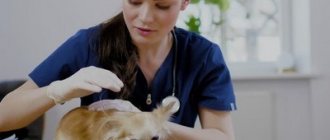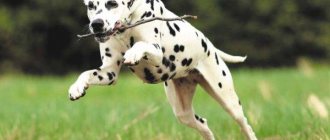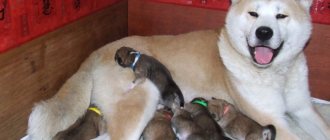Height of dogs of different breeds
In most cases, puppies grow rapidly up to 6 months; in representatives of small breeds, growth slows down earlier than in larger ones.
Puppies of large breeds grow and develop after six months of age, although not so quickly.
Let's look at the growth of some breeds:
- Pekingese - these small dogs grow on average up to 9 months, males often up to a year.
- Yorkshire Terriers - their growth continues up to 7-8 months.
- Chihuahuas are very small and fragile puppies that grow up to 8 months, and after a year they become much stronger.
- Dachshund - the growth of puppies stops at 8 months, after which they continue to grow, but only in width.
- Pug - the growth of these puppies varies - it can stop at six months or continue up to 9 months, while they rapidly gain weight.
- Rottweilers are a powerful and large breed, puppies grow up to 12 months, and the development of the muscular corset occurs until 2 years of age.
- German Shepherd – active growth is observed up to one year, and the dog is fully formed by two years.
But it is worth considering that the above data are only average figures, because in addition to the ratio to the breed, there are also a lot of equally important factors that influence the growth and development of a dog:
- proper, balanced nutrition;
- absence or presence of training;
- conditions for keeping the pet;
- hereditary predisposition to diseases.
It will be useful to read:
- How to determine a dog's age
- How to determine the breed of a dog
- Pros and cons of sterilizing dogs
All about when a puppy's eyes open and starts walking
The dog's offspring are born deaf and blind. After some time, the puppies' eyes open, this happens in one day or several. If the process is delayed, you cannot intervene or solve the problem yourself; it is better to contact a specialist. Late insight does not mean a lag in physical and mental development.
Features of development
Despite appearances, a newborn puppy is not as helpless as it seems. Little dogs immediately smell and feel warmth.
From the moment of birth until the opening of the eyes, the baby goes through a vegetative period, which is characterized by active growth. At this stage, it is possible to distinguish a weak representative from a strong one.
More developed pets are the first to reach their mother's nipples, push their brothers aside, and gain weight faster.
The period from the day the chicks eyes open to the appearance of hearing is called awakening. On days 15-17, puppies of large and medium breeds try to stand on their paws. The next stage of development, adaptation, lasts until one month of age. But a lot depends on the dog’s breed, maintenance, feeding, and mother’s health.
Why do puppies have their eyes closed?
Closing the eyelids at birth protects little dogs from environmental influences. Dogs are predators by nature. When hunting, their especially valuable qualities are hearing and vision. That is why almost all representatives of this branch of the animal world are born blind and deaf. In this way, nature protects the most important elements of the health of the offspring.
Another reason is the birth of puppies not fully mature. This is due to the hunting purpose of dogs. Their ancestors led an active lifestyle during pregnancy. Heavy and large offspring could interfere with the process, so children were born in large numbers, but not mature.
At what age do puppies' eyes open?
Development in children does not occur in parallel. Puppies in the same litter begin to see and hear at different times. This is due to the characteristics of individual development. In many ways, the day when the puppies' eyes open depends on the due date. Post-term babies often begin to see and hear earlier.
: Table of daily food intake depending on the age of the puppy
Normally, the time for epiphany is 10-15 days. The process takes place over several days. A small gap appears in the corner of the eyes. Then the eyelids gradually open. The dog begins to fully see the world in a month.
Puppy development
Small pets begin to crawl after they open their eyes. At this time, they and their mother need to be placed in a separate enclosure, since the dogs fulfill their natural needs outside the place intended for their keeping.
Healthy puppies begin to walk at approximately 20 days of age. If the baby has not started walking by 30 days, you should contact a specialist.
Lack of hearing is more difficult to control. When a dog does not respond to sounds at the age of a month, this is a reason to go to the veterinarian.
The first liquid complementary foods should be introduced 2 weeks after the date of birth. Puppies can be given nutritious food when their baby teeth appear.
Interesting article: Changing teeth in puppies: at what age do puppies change their baby teeth
From the age of one month, the dog can already be instilled with basic concepts and begin to educate it.
Possible problems
The reasons why puppies' eyes do not open can be:
- conjunctivitis;
- microbes getting into the gap between the eyelids;
- accumulation of specks and dirt on eyelashes.
The main symptom of eye problems is purulent discharge. To avoid further complications, it is necessary to treat these areas with one of these products:
- chamomile infusion;
- strong tea;
- furatsilin solution;
- antibiotic drops.
If the eyelids are fused, you should contact a veterinary clinic; surgery may be necessary. While there is no purulent discharge, you can try wiping your eyes daily with warm water.
Stages of dog development and growth
A healthy, normally developed puppy should grow in accordance with a certain pattern.
The concept of growth includes several stages:
- changes in the puppy's weight;
- body growth;
- external changes (exterior);
- physiological characteristics.
The concepts of growth and development have different meanings, but if the pet is healthy, then they occur in a timely manner.
There are several stages of growth and development of puppies:
- The first stage is considered to be the period when the puppy is still in the womb. This period is very important, since this is where the main qualities of the future dog are laid. And here it is worth choosing a future family member more carefully, based on information about his parents and the reputation of the breeders.
- The second stage is considered to be the time when the baby is breastfed, the so-called suckling period, which lasts from birth to one and a half months. At this time, the breeder is responsible for the well-being and growth of the babies, and he also bears full responsibility for the small pets. If the puppy is strong and the future owners have experience in feeding one-month-old puppies, then you can wean him from his mother a little earlier to be completely sure of his proper feeding and further growth.
- The third stage is longer, lasting from 1.5 to 6 months. Most often, during this time period, puppies end up with new owners. At this time, the puppy is growing very rapidly, his milk teeth are changing. Here, the owner is solely responsible for all processes.
- The fourth stage - from 16 to 12 months, is quite varied and depends on the breed of the puppy. It can be accompanied by active growth, its slowdown, or a complete stop.
- The fifth stage is no longer the growth of a puppy, but the processes of formation of an adult, albeit young, dog. Its duration is on average 2-2.5 years. While stopping in growth, the animal continues to gain muscle mass.
It is important to have an idea of what measurement data corresponds to the norm in a given period. Of course, there are no exact figures, but a certain trend can still be observed.
The growth and development of puppies and their characteristics largely depend on their age. In order to properly organize the raising and raising of a puppy, you need to know and take into account these features.
“Growth is understood as the process of increasing the size of an organism, its mass, which occurs due to the accumulation of active, mainly protein, substances in it.” The growth of a dog is accompanied by an increase in its body weight and a change in its proportions.
“The development of an animal is understood as the process of increasing the complexity of the organism, the specialization and differentiation of its organs and tissues. In other words, development is the qualitative processes that every organism goes through from a fertilized egg to an adult, capable of reproduction and similar in basic features to the parent organism.”
The growth and development of puppies depend not only on their age, but also on the hereditary inclinations received from their parents, as well as on their gender, conditions of keeping and rearing, and the number of puppies in litters. Males in most cases have greater height and greater body weight. Small litters (two to five puppies) tend to have larger puppies than larger litters (eight to ten puppies or more).
Since ancient times, in the practice of service dog breeding, five main stages of growth and development of dogs have been distinguished: intrauterine (embryonic) lasting 58-66 days; suckling - from birth to 30-45 days of age; puppies - from 1-1.5 to 6 months; young animals - from 6 to 8-10 months; young dogs from 8-10 months to 2-2.5 years.
Scientists from the I.P. Pavlov Institute of Physiology of the USSR Academy of Sciences (N.M. Vavilova, V.G. Kassil, etc.) made a great contribution to the study of age-related characteristics of the growth and development of puppies. They identified four periods in the individual life of dogs from birth to puberty and described in detail the changes that puppies undergo in their bodies and their behavior in each of these periods. In addition, they made important practical, scientifically based recommendations for the upbringing and initial training of puppies.
The first period: from the 1st to the 18th-21st day of a puppy’s life is a period of predominantly unconditional reflex adaptation.
Puppies are born blind and deaf, not adapted to independent life, and need constant maternal care. However, from the first day of life they are able to crawl a little, find nipples and suck mother's milk. Their sense organs include olfactory, gustatory, skin-temperature and vestibular. There is a large daily increase in body weight, including the brain. Puppies sleep most of the day. By the 15-18th day of life, they already see and hear, are able to perceive and differentiate (distinguish) objects in the environment, develop conditioned reflexes, and form numerous conditioned reflex connections. By the 18-21st day of life, puppies are able to stand, walk, and then run, show a clear indicative reaction to external stimuli and develop defensive conditioned reflexes. From this time on, they gain life experience and learn to adapt to life in a constantly changing external environment.
Second period: from 18-21 to 30-35 days - the period of primary conditioned reflex adaptation. As in the first period, there is an intense daily increase in body weight, including the brain. Puppies become capable of developing conditioned reflexes not only to food stimuli (treats), but also to defensive reinforcement (hand pressure, etc.). However, the rate of formation of conditioned reflexes is still low; multiple repetitions of exercises are required.
Puppies periodically move away from their mother, get acquainted with surrounding objects, participate in games with peers, and gain life experience.
Third period: from 5-6 to 8-12 weeks - the exalted period. This is the most important period for the opportunities for raising and initial training of puppies. Daily weight gain in the body, including the brain, slows down. The puppies now live without a mother; their owners take on all their care and upbringing.
At this age, puppies are very similar in behavior. They are affectionate, inquisitive, and sociable. Their behavior is dominated by research activity. If in the second period of life, when meeting external stimuli (people, animals, etc.), puppies only become wary, then in the third they approach them and try to explore them. So, for example, when meeting strangers, they run up to them, sniff, caress, jump, and sometimes bark without malice.
During this period, they easily develop positive skills associated with any activity. Therefore, starting from 1.5-2 months of age, after accustoming the puppy to its nickname, you should move on to teaching it to carry out the commands “Place”, “Come to me”, “Walk”. At the same time, in the third period of life, it is still difficult for puppies to develop inhibitory reactions necessary for teaching puppies to carry out commands such as “Sit”, “Lie down”, “Fu”; this is possible only from the end of the third and beginning of the fourth period of the puppies’ life, when they are already capable of exhibiting inhibitory reactions. Failure to comply with this rule will negate your efforts, and if the puppy is severely overloaded, extreme inhibition cannot occur, which in turn can cause the animal to become ill.
In the third period, regular walks, gradually increasing in time and complexity of the environment, are necessary, both for physical development and for the accumulation of life experience of the puppy.
The fourth period: from 3-4 to 6-7 months is the period of formation of the typological characteristics of the nervous system.
An observant dog breeder will notice that if puppies of 1.5-3 months of age are similar in behavior to each other, then starting from 3-4 months their behavior is noticeably different. Animals are identified that exhibit a passive-defensive reaction to strangers and other complex stimuli. When meeting strangers, they do not run up to them, do not start games, but only watch them from the side, and at the first time strangers display even mildly expressed threatening actions, some puppies run away. Thus, from 3-4 months of age, the intensity of research activity noticeably decreases and passive-defensive behavior appears.
The nature of the manifestation of a passive-defensive reaction also changes noticeably. In young puppies, it occurs only in response to simple stimuli, for example, sudden light, sound, etc., perceived by the corresponding analyzers (sense organs). With proper upbringing (distracting the puppy with games, treats, calming him down), this reaction quickly passes and is replaced by an indicative reflex (OR). In puppies that have reached 3-4 months and older, a passive defensive reaction manifests itself not only to simple, isolated stimuli, but also to more complex, complex ones, such as, for example, new objects, people, animals. At this age, puppies are already capable of demonstrating analytical and synthetic activity. It should, however, be taken into account that the extinction of the passive-defensive reaction to complex stimuli occurs more slowly than to simple stimuli, and requires careful, affectionate treatment from the owner of the puppy and repeated repetition of the situation in which it manifests itself.
A change in the behavior of puppies from 3-4 months of age, namely the manifestation of a passive-defensive reaction, requires increased attention from the owners, calm handling, and timely adoption of measures to calm the animals.
It should be borne in mind that the period for the appearance of a passive-defensive reaction in puppies is indicated by us only for the vast majority of puppies, but it can occur earlier (from 2-2.5 months of age) or later (after 4 months of age), which depends on the individual characteristics of the puppies and their breed.
Source: V.N. Zubko. Raising a puppy
Period from birth to 6 months
From birth to six months, a healthy, active puppy should increase in weight by three times, and grow at the withers by two times. At this time, dogs only grow in height.
This stage is characterized by the cessation of growth of tubular bones. Therefore, it is very important that at this time everything is formed according to the norm. Improper, unbalanced nutrition, serious illnesses can negatively affect the development of the bone frame, resulting in deformations and obvious disorders that cannot be corrected.
In this case, the adult will have incorrect body proportions, which will put an end to exhibitions and participation in competitions.
Growth of puppies over 6 months
In puppies, from the age of six months, the growth of flat bones occurs, that is, the chest bone actively develops, the pets grow, but already in width. These processes last intensively for about 6 months, and after a year growth continues, but at a slower pace.
A dog's bone structure is fully formed by the age of three. Small breeds finish developing much earlier than large ones.
The growth of the pet is affected by the first mating, after which the animal’s growth stops completely. This is one of the reasons to avoid early matings, so as not to disrupt the development and growth of the dog.
To record metric data, it is necessary to measure the dog at certain periods and record all data. To weigh the puppy, you can use household scales, but if the pet is a large breed - St. Bernards, Caucasian Shepherds, then large commercial scales will be needed.
In addition, the following parameters are measured:
- sternum girth;
- height (height at withers);
- length of hind and front legs.
To remove them, measuring tapes, tape measures and rulers are used.
Until six months of age, it is recommended to measure your pet every 10 days; at a later age, once a month will be enough.
When do puppies open their eyes?
After birth, babies are completely helpless and cannot live without their mother. They don’t see or hear anything, and have difficulty navigating in space without help. Beginning dog breeders are most interested in how many days after birth babies begin to open their eyes.
It is difficult to name the exact day; it all depends on the individual characteristics of the animal. The average time is the period from 10 to 15 days from the moment of birth. The process itself takes from 1 to 4 days. It often happens that one eye opens before the other. There's nothing wrong with that. This feature is associated with the development of the puppy, and it is individual for each baby.
The maximum period for a baby's eyes to fully open is 20 days from the date of birth. A later discovery may indicate developmental abnormalities or illness. You need to go to a veterinary clinic and show the baby to a doctor.
The breeder can speed up the opening of the eyes a little. To do this, you need to carefully wipe them with a cotton pad soaked in clean warm water. This can only be done with clean hands. You cannot wipe both eyes with one disc; you need to change the material. Under no circumstances should you force your eyelids apart! Late opening of the eyes can lead to stunted development of the dog, because this is one of the ways to explore the world around and communicate with other animals and people.
I wonder why puppies are not born with their eyes open right away? This is due to the fact that at the moment of birth their eyelids do not fully develop. Their development continues after birth. A dog's eyelids have an important function - they help to navigate normally in space. This subsequently affects the socialization of the dog. Here are the reasons why babies are not born immediately with their eyes open:
- Early opening of the eyelids negatively affects the growth of the pet due to underdevelopment. The baby must have time to receive all the substances necessary for normal development through mother’s milk.
- After birth, not only the outer eyelid continues to form, but also the retina. It fully develops only by the third week of a dog’s life. During this entire time, it is better not to expose the box with the offspring to bright light.
For the normal development of a puppy from birth, you need to monitor his behavior and the development of his senses.
This is very important for the further development of the dog’s character and the ability to communicate with other animals and people. Therefore, it is better for the breeder to monitor when the puppies open their eyes
Proper feeding of a puppy
Nutrition plays a big role in the growth and development of a dog. Ideally, a diet, including the number of feedings, the composition of the diet, based on individual and breed characteristics, should be developed by a dog handler.
On average, a puppy up to 3 months old should eat at least 5-6 times a day. An older pet is gradually transferred to four feedings a day. From 6 months, the number of feedings can be reduced to two, as for an adult dog.
Do not forget that from six months the pet experiences an intensive gain of muscle mass, so the diet must be enriched with proteins, vitamins and microelements.
Dog owners have a choice - to feed their pet with natural products or ready-made food - dry or wet. Sometimes there is a successful combination of these two types.
If the puppy owner chooses to feed dry or wet food, then he must choose a good super-premium food. Such products contain all important micro- and macroelements, vitamins, sufficient amounts of proteins, fats and carbohydrates.
The balance of the finished food affects the normal development of the puppy. In addition, most manufacturers, when producing such products, take into account age characteristics and other nuances.
Those owners who prefer natural nutrition should follow the following recommendations:
- Eliminate too spicy, fatty, smoked, and salty foods from your diet.
- It is best to buy sea fish after boiling it first. Raw fish and meat can lead to infection with helminthic infestations.
- Bones are poorly digestible, so it is not advisable to give them to your pet to chew on.
- Sweets and chocolate lead to diabetes, disorders of the cardiovascular system, loss of vision and teeth, so their consumption is excluded.
- You can give low-fat cheese, cottage cheese, boiled meat, raisins, dried fruits, etc.
- Food should be at room temperature so as not to disrupt the digestion process.
Proper feeding, caring care and attentive attitude towards your pet will help it grow and develop normally.
Dog development and growth are individual, just like people. Moreover, even animals of pure blood can, having reached the limits of their size, differ from the standard recognized in a given breed. Usually, in any breed of dog, males are larger than females, although puberty occurs at about the same time for them.
Therefore, to evaluate a dog, you should focus on the puppy’s health, and not on its size, which may not be as expected. In this case, there is no reason to worry, although such a non-standard dog will no longer be able to participate in the exhibition.
Sources:
https://dogipedia.ru/do-kakogo-vozrasta-rastut-sobaki/
https://zen.yandex.ru/media/petsblog/do-kakogo-vozrasta-rastut-sobaki-5d00f5026a842f00aef7806e










